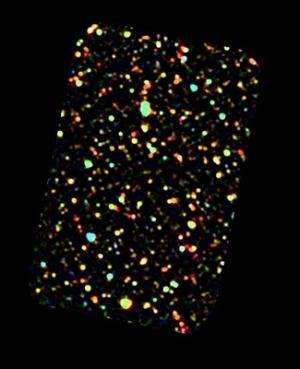The diversity of distant galaxies

(Phys.org) —With the advent of powerful space infrared telescopes like the Spitzer Space Telescope and the (recently deceased) Herschel Space Telescope, astronomers have been able to study the properties of dust in galaxies so remote that their light has been traveling towards us for over ninety percent of the age of the universe. That these distant objects are detected at all is because they are very bright in the infrared, and they are bright because they are making huge numbers of stars whose light warms the dust that in turn radiates at infrared wavelengths.
Local galaxies - those only hundreds of millions of light-years away in our cosmic neighborhood - provide a template for understanding how galaxies behave, and are the basis for models of their distant cousins. It has been known for decades that the early universe was actively making stars in galaxies. A key question for astronomers is whether distant galaxies are different enough from local ones that different physical processes need to be included in the models, or whether comparisons with local objects are valid.
CfA astronomer Ho Seong Hwang and a large team of his collaborators have analyzed a large sample of distant galaxies to address this question. The Herschel Space Telescope during its lifetime observed many distant infrared galaxies. The astronomers selected 2500 of them from a set of over fifty thousand, based on their having clear detections at several infrared wavelengths with ancillary data from other missions. The sample was selected in a way that was independent of observer preferences, like extreme brightness, that might compromise the conclusions, the first time this has been done for such a large sample.
The results were surprising. The scientists found that the dust in remote luminous galaxies tended to be warmer than it is in local galaxies of the same luminosity. Together with other indicators, the data suggest that the character of the dust and its environments have evolved with time in ways that are still not well known. Probably as a result of the dust variations there also appears to be a greater diversity of types of galaxies in the early universe. Finally, the new paper notes, in accord with other recent papers, that there are indications that these galaxies may have started forming sooner after the big bang than had been anticipated in some old models.
Provided by Harvard-Smithsonian Center for Astrophysics





















